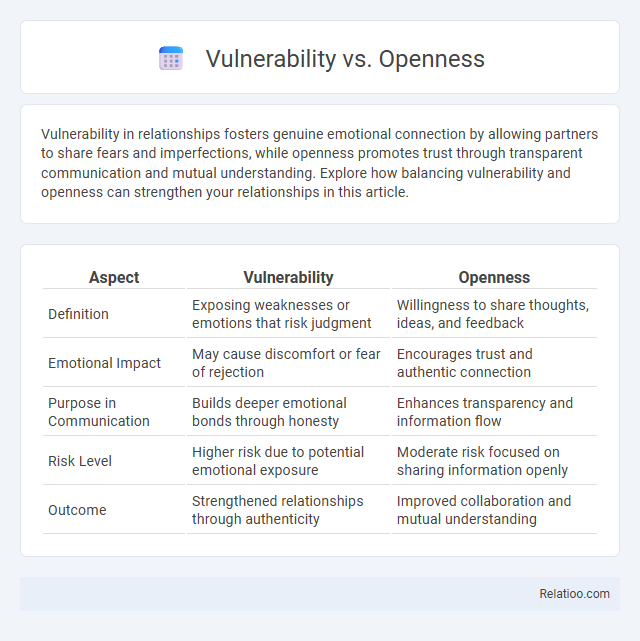Vulnerability in relationships fosters genuine emotional connection by allowing partners to share fears and imperfections, while openness promotes trust through transparent communication and mutual understanding. Explore how balancing vulnerability and openness can strengthen your relationships in this article.
Table of Comparison
| Aspect | Vulnerability | Openness |
|---|---|---|
| Definition | Exposing weaknesses or emotions that risk judgment | Willingness to share thoughts, ideas, and feedback |
| Emotional Impact | May cause discomfort or fear of rejection | Encourages trust and authentic connection |
| Purpose in Communication | Builds deeper emotional bonds through honesty | Enhances transparency and information flow |
| Risk Level | Higher risk due to potential emotional exposure | Moderate risk focused on sharing information openly |
| Outcome | Strengthened relationships through authenticity | Improved collaboration and mutual understanding |
Understanding Vulnerability and Openness
Understanding vulnerability means recognizing your own emotional risks and uncertainties, allowing you to authentically connect with others. Openness involves a willingness to share thoughts and feelings transparently, fostering trust and deeper relationships. Balancing vulnerability and openness helps you build meaningful connections while protecting your emotional well-being.
Defining Vulnerability in Human Relationships
Vulnerability in human relationships is the courage to show your true self, including fears and imperfections, fostering trust and deeper connections. Openness involves sharing thoughts and feelings freely but does not necessarily include the risk and exposure inherent in vulnerability. Understanding the distinction helps you build meaningful bonds grounded in authenticity and emotional safety.
The Essence of Openness in Communication
Openness in communication fosters trust by encouraging honesty, transparency, and active listening, creating a safe space for meaningful dialogue. Vulnerability allows you to express genuine feelings and thoughts without fear of judgment, deepening connections and understanding between individuals. Balancing vulnerability with openness helps build resilient relationships where both parties feel valued and heard.
Key Differences Between Vulnerability and Openness
Vulnerability involves exposing oneself to potential emotional risk and uncertainty, often requiring trust and courage, while openness refers to a willingness to share thoughts and feelings transparently without necessarily facing risk. The key difference lies in vulnerability's association with exposure to possible harm or judgment, whereas openness emphasizes honesty and receptivity without inherent threat. Understanding these distinctions helps improve interpersonal communication by balancing honesty with emotional safety.
Psychological Benefits of Embracing Vulnerability
Embracing vulnerability fosters emotional resilience by encouraging authentic self-expression and deeper interpersonal connections, which significantly reduce stress and anxiety levels. Psychological studies link vulnerability to increased empathy and trust, enhancing overall mental well-being and promoting a growth mindset. This openness enables individuals to confront challenges with courage and adaptability, leading to sustained personal development and improved life satisfaction.
Cultivating Openness for Authentic Connections
Cultivating openness fosters authentic connections by encouraging honest communication and emotional transparency, essential for building trust and deeper relationships. Vulnerability is a crucial component, allowing individuals to share their true selves without fear of judgment, which strengthens interpersonal bonds. Prioritizing openness over guardedness creates a safe environment where meaningful connections thrive, enhancing empathy and mutual understanding.
Challenges and Risks of Being Vulnerable
Being vulnerable in personal and professional contexts exposes individuals to risks such as judgment, rejection, and emotional harm, which can hinder authentic connections. Openness requires a balance, as excessive transparency may lead to exploitation or misunderstandings, emphasizing the importance of setting boundaries. Navigating these challenges demands emotional intelligence and resilience to mitigate the potential negative impacts of vulnerability.
The Role of Trust in Vulnerability and Openness
Trust serves as the foundation for both vulnerability and openness by creating a safe environment where individuals feel secure to share personal thoughts and feelings. Your willingness to be vulnerable is often influenced by the level of trust established, enabling deeper emotional connections and authentic communication. Openness thrives when trust reduces fear of judgment, allowing honest exchanges that strengthen relationships and foster mutual understanding.
Practical Strategies to Balance Vulnerability and Openness
Balancing vulnerability and openness requires setting clear personal boundaries while maintaining authentic communication to build trust. Practical strategies include practicing mindful self-disclosure, where sharing is intentional and contextually appropriate to foster connection without overexposure. Developing emotional resilience through reflection and feedback allows individuals to navigate openness safely, promoting healthy relationships and psychological well-being.
Building Healthy Connections Through Vulnerability and Openness
Building healthy connections requires balancing vulnerability and openness, as both foster trust and authentic communication. Your willingness to be vulnerable allows others to see your true self, while openness invites mutual understanding and emotional safety. Together, they create a foundation for deep, meaningful relationships that promote empathy and resilience.

Infographic: Vulnerability vs Openness
 relatioo.com
relatioo.com